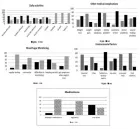Abstract
Research Article
Risk Factors Associated to Patients with Type 2 Diabetes in Lahore District
Snobia Munir*, Samreen Riaz, Tooba Arshad and Aasma Riaz
Published: 21 May, 2020 | Volume 4 - Issue 1 | Pages: 011-019
Our research aimed to check the impact of some significant risk variables on diabetes growth and the specific goal of this study was to evaluate the connection of industrial fields with diabetes risk variables. The current research also informs us about the most important risk factor for male and female people with diabetes. A cross-section and convenient sample of 100 people, male and female, without discernment of risk factors and diabetes mellitus (Meta-Analysis on the effect of major risk factors on the diabetic patients form Jinnah Hospital Lahore). The risk factors in the general assessment i.e. lack of exercise, kidney problems, high ranges of tests and residence in industrial areas are found to be significant. Assessment of these factors is helpful in early diagnosis and in prognosis of diabetes.
Read Full Article HTML DOI: 10.29328/journal.acem.1001014 Cite this Article Read Full Article PDF
Keywords:
Major risk factors; Meta-analysis; Convenient sampling; Associations; Industrial area
References
- World Health Organization. Country Profiles: Pakistan. World Health Organization. 2018.
- Wild S, Roglic G, Green A, Sicree R, King H. Global prevalence of diabetes: estimates for the year 2000 and projections for 2030: response to Rathman and Giani. Diabetes care. 2004; 27: 2568-2569. PubMed: https://pubmed.ncbi.nlm.nih.gov/15451946/
- Shoback DG, Gardner D, eds. Diabetes mellitus. Greenspan's basic & clinical endocrinology Chapter 17. (9th ed.). New York: McGraw-Hill Medical. 2011.
- World Health Organization. Definition, diagnosis and classification of diabetes mellitus and its complications: report of a WHO consultation. Part 1, Diagnosis and classification of diabetes mellitus, Geneva: World health organization. 1999.
- Michalek JE, Pavuk M. Diabetes and cancer in veterans of Operation Ranch Hand after adjustment for calendar period, days of spraying, and time spent in Southeast Asia. J Occup Environ Med. 2008; 50: 330-340. PubMed: https://pubmed.ncbi.nlm.nih.gov/18332783/
- Kang ES, Kim HJ, Nam M, Nam CM, Ahn CW, et al. A novel 111/121 diplotype in the Calpain-10 gene is associated with type 2 diabetes. J Hum Genet. 2006; 51: 629-633. https://pubmed.ncbi.nlm.nih.gov/16721485/
- Yi B, Hu X, Zhang H, Huang J, Liu J, et al. Nuclear NF-κB p65 in peripheral blood mononuclear cells correlates with urinary MCP-1, RANTES and the severity of type 2 diabetic nephropathy. PLoS One. 2014; 9: e99633. PubMed: https://pubmed.ncbi.nlm.nih.gov/24936866/
- Kuo CC, Moon K, Thayer KA, Navas-Acien A. Environmental chemicals and type 2 diabetes: an updated systematic review of the epidemiologic evidence. Curr Diab Rep. 2013; 13: 831-849. PubMed: https://pubmed.ncbi.nlm.nih.gov/24114039/
- Fernández JS. Iron Excess and Risk of Type 2 Diabetes Mellitus in a Prospective Cohort of Mediterranean Population. Cambridge Core. 2016; 112:
- Kanan S, Samara S. Dioxins and furans: A review from chemical and environmental perspectives. Trends in Environmental Analytical Chemistry. 2018; 17: 1-13.
- Kitabchi AE, Umpierrez GE, Miles JM, Fisher JN. Hyperglycemic crises in adult patients with diabetes. Diabetes Care. 2009; 32: 1335–1343. PubMed: https://www.ncbi.nlm.nih.gov/pmc/articles/PMC2699725/
- Pourfarzam M, Zadhoush F, Sadeghi M. The difference in correlation between insulin resistance index and chronic inflammation in type 2 diabetes with and without metabolic syndrome. Adv Biomed Res. 2016; 5: 153. PubMed: https://www.ncbi.nlm.nih.gov/pmc/articles/PMC5046740/
Figures:

Figure 1
Similar Articles
-
Risk Factors Associated to Patients with Type 2 Diabetes in Lahore DistrictSnobia Munir*,Samreen Riaz,Tooba Arshad,Aasma Riaz. Risk Factors Associated to Patients with Type 2 Diabetes in Lahore District. . 2020 doi: 10.29328/journal.acem.1001014; 4: 011-019
Recently Viewed
-
Indian spices and Caffeine treatment for Obesity and Cardiovascular diseaseIan James Martins*. Indian spices and Caffeine treatment for Obesity and Cardiovascular disease. Ann Clin Endocrinol Metabol. 2018: doi: 10.29328/journal.acem.1001005; 2: 010-014
-
Intravenous Leiomyomatosis of the Uterus with Intracardiac ExtensionTomas Reyes-del Castillo*,Minerva I Hernandez-Rejon,Jose L Ruiz-Pier,Mario Peñaloza-Guadarrama,Carlos E Merinos-Avila,Cristina Juarez-Cabrera,Pedro A del Valle-Maldonado,Sofia Ley-Tapia,Valentín Gonzalez-Flores. Intravenous Leiomyomatosis of the Uterus with Intracardiac Extension. Arch Vas Med. 2025: doi: 10.29328/journal.avm.1001021; 9: 003-007
-
Hepato-Pulmonary syndrome and Porto-Pulmonary Hypertension: Rare combination cause of Hypoxemia in patient with end-stage renal failure on Hemodialysis and hepatitis C Induced Decompensated CirrhosisAwad Magbri*,Mariam El-Magbri,Eussera El-Magbri. Hepato-Pulmonary syndrome and Porto-Pulmonary Hypertension: Rare combination cause of Hypoxemia in patient with end-stage renal failure on Hemodialysis and hepatitis C Induced Decompensated Cirrhosis. Arch Vas Med. 2017: doi: 10.29328/journal.avm.1001002; 1: 008-012
-
Deep Learning-Powered Genetic Insights for Elite Swimming Performance: Integrating DNA Markers, Physiological Biometrics and Performance AnalyticsRahul Kathuria,Reeta Devi,Asadi Srinivasulu*. Deep Learning-Powered Genetic Insights for Elite Swimming Performance: Integrating DNA Markers, Physiological Biometrics and Performance Analytics. Int J Bone Marrow Res. 2025: doi: 10.29328/journal.ijbmr.1001020; 8: 006-015
-
Pure Erythroid Leukemia: The Sole Acute Erythroid LeukemiaFauzia Shafi Khan*,Khalid Mahmood,Alia Ahmad. Pure Erythroid Leukemia: The Sole Acute Erythroid Leukemia. Int J Bone Marrow Res. 2017: doi: 10.29328/journal.ijbmr.1001001; 1: 001-005
Most Viewed
-
Impact of Latex Sensitization on Asthma and Rhinitis Progression: A Study at Abidjan-Cocody University Hospital - Côte d’Ivoire (Progression of Asthma and Rhinitis related to Latex Sensitization)Dasse Sery Romuald*, KL Siransy, N Koffi, RO Yeboah, EK Nguessan, HA Adou, VP Goran-Kouacou, AU Assi, JY Seri, S Moussa, D Oura, CL Memel, H Koya, E Atoukoula. Impact of Latex Sensitization on Asthma and Rhinitis Progression: A Study at Abidjan-Cocody University Hospital - Côte d’Ivoire (Progression of Asthma and Rhinitis related to Latex Sensitization). Arch Asthma Allergy Immunol. 2024 doi: 10.29328/journal.aaai.1001035; 8: 007-012
-
Causal Link between Human Blood Metabolites and Asthma: An Investigation Using Mendelian RandomizationYong-Qing Zhu, Xiao-Yan Meng, Jing-Hua Yang*. Causal Link between Human Blood Metabolites and Asthma: An Investigation Using Mendelian Randomization. Arch Asthma Allergy Immunol. 2023 doi: 10.29328/journal.aaai.1001032; 7: 012-022
-
An algorithm to safely manage oral food challenge in an office-based setting for children with multiple food allergiesNathalie Cottel,Aïcha Dieme,Véronique Orcel,Yannick Chantran,Mélisande Bourgoin-Heck,Jocelyne Just. An algorithm to safely manage oral food challenge in an office-based setting for children with multiple food allergies. Arch Asthma Allergy Immunol. 2021 doi: 10.29328/journal.aaai.1001027; 5: 030-037
-
Snow white: an allergic girl?Oreste Vittore Brenna*. Snow white: an allergic girl?. Arch Asthma Allergy Immunol. 2022 doi: 10.29328/journal.aaai.1001029; 6: 001-002
-
Cytokine intoxication as a model of cell apoptosis and predict of schizophrenia - like affective disordersElena Viktorovna Drozdova*. Cytokine intoxication as a model of cell apoptosis and predict of schizophrenia - like affective disorders. Arch Asthma Allergy Immunol. 2021 doi: 10.29328/journal.aaai.1001028; 5: 038-040

If you are already a member of our network and need to keep track of any developments regarding a question you have already submitted, click "take me to my Query."
















































































































































